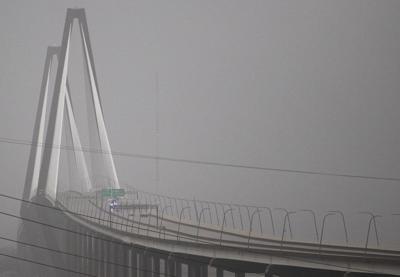Well, that didn't take long. Less than 20 years after South Carolina's largest, widest and most costly bridge was built over the Cooper River, some are asking whether it's large and strong enough to handle its increasing traffic flow.
As The Post and Courier's Eva Herscowitz noted in a recent article, "Can the Ravenel bridge handle more traffic?" the number of cars and trucks crossing the Arthur Ravenel Jr. Bridge has swollen from about 75,500 a day when it opened in 2006 to about 94,400 a day in 2022, the most recent year for which the state has data. And while these growing numbers pose no immediate structural threat to the cable-stayed bridge that defines the Lowcountry skyline, it's increasingly common for traffic to slow to a crawl during peak morning and evening hours — or whenever there's a significant accident.
It's yet another sign that leaders across the Charleston region need to plan for better ways for our growing population to get around town. Specifically, it's time to begin planning for bus rapid transit that would run east-west across the metro region.
The north-south line has been in the works for years: The Lowcountry Rapid Transit line will run 21.3 miles between downtown Charleston and the Ladson fairgrounds, and unlike our region's existing bus service, these new buses will travel at least part of the time in dedicated lanes, avoid significant delays by requiring passengers to pay in advance and even be able to change traffic lights. All those features promise to make the transit line run faster than regular traffic, increasing its appeal and ridership.
Unfortunately, it takes years to develop a new bus rapid transit line because with federal funding (the Federal Transit Administration is paying 60% of the cost) comes federal red tape. The Charleston Area Regional Transportation Authority has been working on the rapid transit line since 2016, when Charleston County voters approved money for it as part of a sales tax extension. Since then, the cost projection has almost doubled, from $360 million to $625 million, and the start of construction is still about two years away. If all goes well, the line is expected to start running by 2029.
That's why CARTA officials and local mayors and councils should start discussing the next line, which would serve West Ashley and Mount Pleasant, as well as a potential northern spur along U.S. Highway 52 toward Goose Creek and beyond.
After all, financing and constructing another bridge alongside the Ravenel Bridge would be far more expensive and might not even be doable, given the intense level of new development near where the span touches down on both sides. In fact, the difficulty of building another bridge or widening the existing one is another example of how hard it has become to build our way out of congestion problems. And then there are the neighboring residents who understandably object to the idea of living near wider, faster, noisier highways, or having their homes taken to accommodate road construction.
Building a better, more expansive bus rapid transit network would take some time and significant political cooperation, as this service would have to span many council districts, municipalities, even counties to work as it should. For just a small fraction of the more than $2 billion some Charleston County Council members hope to spend on a highly controversial highway extension, we could pivot and make a significant down payment on a new way to get around. A more robust public transportation network wouldn't serve as a magic wand that makes our traffic problems vanish, but it would help us make more efficient use of the roads we have and slow the pace at which congestion worsens, all while preserving and protecting our special sense of place.
Will the Charleston region's new set of leaders work together on a new vision or pursue more of the same?
Click here for more opinion content from The Post and Courier.







